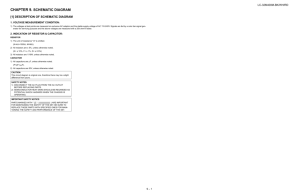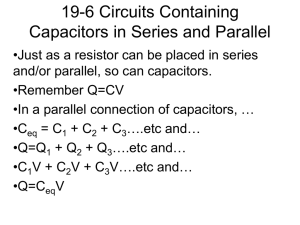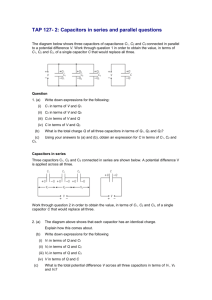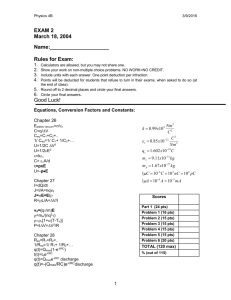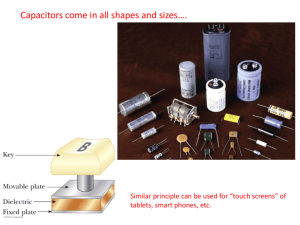How to Choose Replacement Capacitors when repairing and restoring high-quality
advertisement
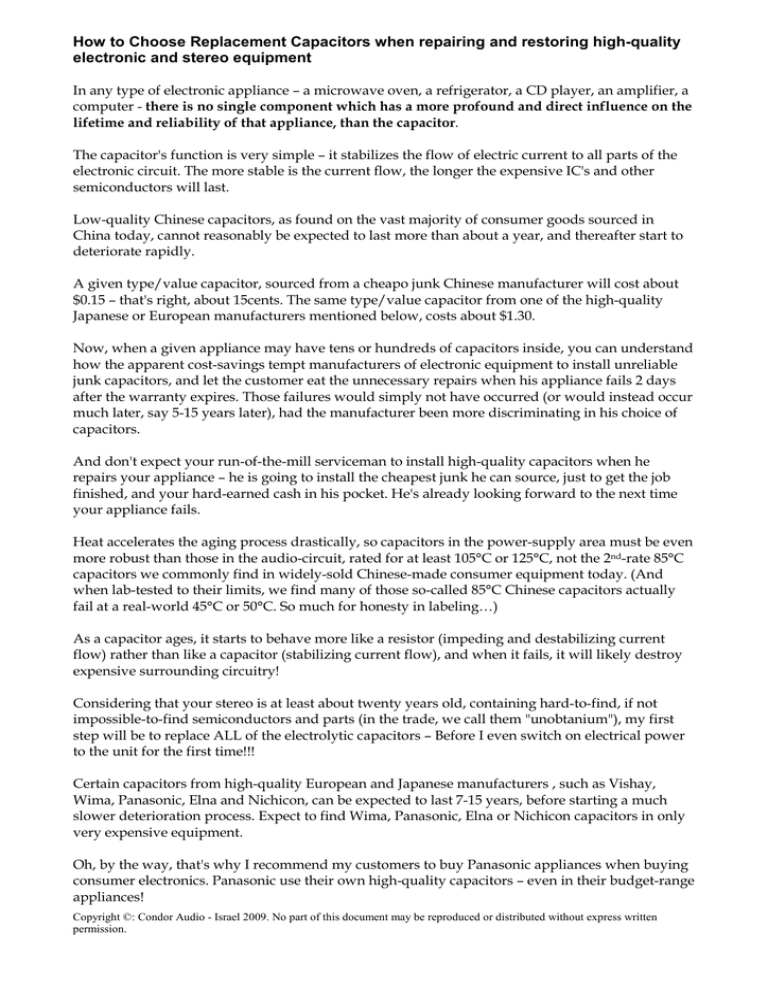
How to Choose Replacement Capacitors when repairing and restoring high-quality electronic and stereo equipment In any type of electronic appliance – a microwave oven, a refrigerator, a CD player, an amplifier, a computer - there is no single component which has a more profound and direct influence on the lifetime and reliability of that appliance, than the capacitor. The capacitor's function is very simple – it stabilizes the flow of electric current to all parts of the electronic circuit. The more stable is the current flow, the longer the expensive IC's and other semiconductors will last. Low-quality Chinese capacitors, as found on the vast majority of consumer goods sourced in China today, cannot reasonably be expected to last more than about a year, and thereafter start to deteriorate rapidly. A given type/value capacitor, sourced from a cheapo junk Chinese manufacturer will cost about $0.15 – that's right, about 15cents. The same type/value capacitor from one of the high-quality Japanese or European manufacturers mentioned below, costs about $1.30. Now, when a given appliance may have tens or hundreds of capacitors inside, you can understand how the apparent cost-savings tempt manufacturers of electronic equipment to install unreliable junk capacitors, and let the customer eat the unnecessary repairs when his appliance fails 2 days after the warranty expires. Those failures would simply not have occurred (or would instead occur much later, say 5-15 years later), had the manufacturer been more discriminating in his choice of capacitors. And don't expect your run-of-the-mill serviceman to install high-quality capacitors when he repairs your appliance – he is going to install the cheapest junk he can source, just to get the job finished, and your hard-earned cash in his pocket. He's already looking forward to the next time your appliance fails. Heat accelerates the aging process drastically, so capacitors in the power-supply area must be even more robust than those in the audio-circuit, rated for at least 105°C or 125°C, not the 2nd-rate 85°C capacitors we commonly find in widely-sold Chinese-made consumer equipment today. (And when lab-tested to their limits, we find many of those so-called 85°C Chinese capacitors actually fail at a real-world 45°C or 50°C. So much for honesty in labeling…) As a capacitor ages, it starts to behave more like a resistor (impeding and destabilizing current flow) rather than like a capacitor (stabilizing current flow), and when it fails, it will likely destroy expensive surrounding circuitry! Considering that your stereo is at least about twenty years old, containing hard-to-find, if not impossible-to-find semiconductors and parts (in the trade, we call them "unobtanium"), my first step will be to replace ALL of the electrolytic capacitors – Before I even switch on electrical power to the unit for the first time!!! Certain capacitors from high-quality European and Japanese manufacturers , such as Vishay, Wima, Panasonic, Elna and Nichicon, can be expected to last 7-15 years, before starting a much slower deterioration process. Expect to find Wima, Panasonic, Elna or Nichicon capacitors in only very expensive equipment. Oh, by the way, that's why I recommend my customers to buy Panasonic appliances when buying consumer electronics. Panasonic use their own high-quality capacitors – even in their budget-range appliances! Copyright ©: Condor Audio - Israel 2009. No part of this document may be reproduced or distributed without express written permission. My standard replacement policy is as follows: 1. In the Power supply section – Panasonic EB and Nichicon PW. 2. The main power-supply decoupling caps are usually Panasonic TSHA or Nichicon GU snap-ins. 3. In the Audio Path, Nichicon KT, Panasonic FM and sometimes FC, and all electrolytics of 6.8uF and smaller are replaced by Wima MKS2 non-polar film caps. 4. Elsewhere, Panasonic FC and Nichicon HE and PW. 5. For Axial Capacitors, especially in European equipment, I choose Vishay (formerly Philips) 138AML capacitors. Some are blue, and some are light-grey. Copyright ©: Condor Audio - Israel 2009. No part of this document may be reproduced or distributed without express written permission. This policy works, and I've never been disappointed with the results. Note that they are all 105°C or 125°C capacitors, with exceptionally long-life and reliability. Sometimes the customer will specifically request Boutique audio capacitors (Blackgate, Nichicon Muse, Vishay OsCon), and I will install them as per the customer's request. I don't use el-cheapo off-the-shelf Chinese capacitors with no track record. I don't like my customers complaining that their restored stereo isn't working. My goal is an absolute-zero comeback rate for at least 5 years. You may rest assured that regarding component-quality selection, no short-cuts will be taken to trim quality at your expense! Copyright ©: Condor Audio - Israel 2009. No part of this document may be reproduced or distributed without express written permission. How to Choose Replacement Resistors when repairing and restoring high-quality stereo equipment In the old days, the only resistors available were carbon-type. By now, many of these in the power section are way out-of-spec, and need to be replaced. Also, carbon resistors are generally very noisy, so although the original carbon resistors in the audio path may still be within spec, upgrading will achieve significant audible improvement. Modern Metal-oxide resistors, although being quite stable, are also noisy. Generally, I like to upgrade to Metal Film in the signal path, subject to certain technical considerations. In RF circuits, above about 14-18KHz, the impedance of a Metal Film resistor changes - see the attached diagram. So you have to be sure about the resistor value and frequency in RF circuits. In Audio Frequency circuits, generally no problem, because the audio signal ceases at about 15KHz. When I was learning about this phenomenon, I managed to cancel the RF signal completely in a MW radio. I solved the problem quickly with my oscilloscope, and returned the single carbon resistor to its place, but it took me a lot of research to understand why it had happened! To do it properly, you need a frequency counter at each resistor in the signal path, and to measure the frequency being passed through that resistor. Then compare the resistor value to the graph, and determine whether it is in the linear "safe" range. If so, you can exchange it. Copyright ©: Condor Audio - Israel 2009. No part of this document may be reproduced or distributed without express written permission. Therefore my standard policy is to use Metal-film resistors, and my preferred type is Vishay-Dale CMF55 or CMF60 for 1/4W and 1/2W applications. For higher wattage applications, I use Vishay-BC PR01, PR02, and PR03 Metal-film types. In power circuits it is generally NOT a good idea to remove carbon resistors, as carbon handles the pulses much better than any other type of resistor. For TrimPots, I use Bourns 3352, and Piher PTC-10 Cermet units. The Cermet resistive element is far more stable than the carbon elements originally installed in vintage equipment.. http://www.condoraudio.com yachadm@gmail.com Copyright ©: Condor Audio - Israel 2009. No part of this document may be reproduced or distributed without express written permission.


